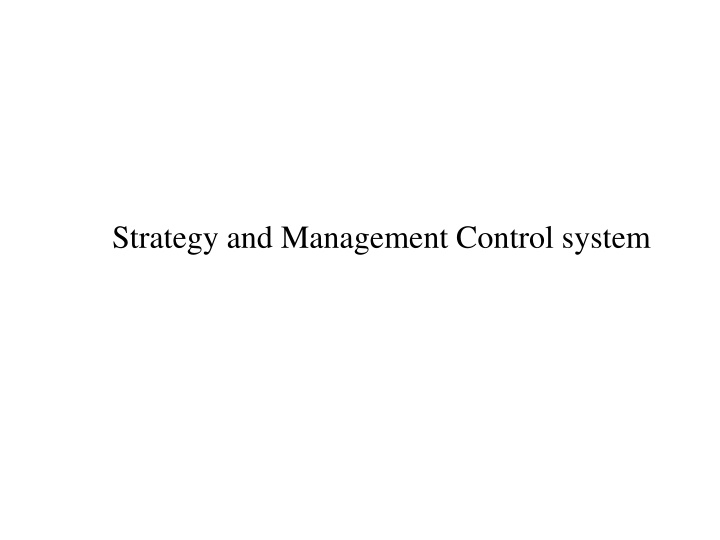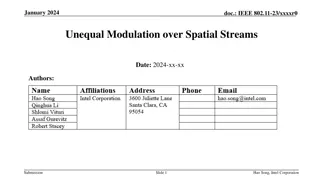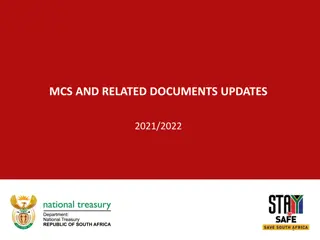
Essence of Strategic Management: Decisions and Implementation
Explore the essence of strategic management including defining business goals, setting objectives, crafting strategies, implementation, and evaluation. Learn about rational and emergent perspectives, developing a mission, and aligning objectives for organizational success.
Download Presentation

Please find below an Image/Link to download the presentation.
The content on the website is provided AS IS for your information and personal use only. It may not be sold, licensed, or shared on other websites without obtaining consent from the author. If you encounter any issues during the download, it is possible that the publisher has removed the file from their server.
You are allowed to download the files provided on this website for personal or commercial use, subject to the condition that they are used lawfully. All files are the property of their respective owners.
The content on the website is provided AS IS for your information and personal use only. It may not be sold, licensed, or shared on other websites without obtaining consent from the author.
E N D
Presentation Transcript
Tasks Involved in Strategic Management & MCS Defining business and stating a mission Setting measurable objectives Crafting a strategy to achieve objectives Implementing a strategy Evaluating performance of the strategy, reviewing new developments and taking corrective action
The essence of strategy of the organization Perspective strategy or rational view An emergent view
Developing a Mission & Objectives An organization s Mission Reflects management s purpose of operating the business Provides a clear view of what the organization is trying to accomplish for its customers Indicates intent to take a business position An organization s Objectives Convert the mission into performance targets Track performance over time Must be achievable Two types Financial outcomes that relate to improving financial performance Strategic outcomes that will result in greater competitiveness & stronger long-term market position
BBCs purpose statement To educate, inform and entertain To educate, inform and entertain Walt Disney s Purpose Statement To make people happy
Management accounting and strategy Objectives - Specific statement of what the organisation aims to achieve, often quantified and relating to a specific period of time (SMART) Strategies - Strategy is the direction and scope of an organisation over the long term which achieves advantage for the organisation through its configuration of resources within a changing environment to fulfil stakeholder expectations. G. Johnson and K. Scholes Exploring Corporate Strategy 6th edition
The essence of strategic management-a perspective view Major decisions - What business will we operate in? - What are our basic directions for the future - What systems and structures should we have in place to support our strategies? Corporate strategy - Decisions about the types of businesses to operate in, which businesses to acquire and divest, and how best to structure and finance the organisation
If DSI confines itself footwear business, can they offer tyres , tubes, schoolbags?
What business are you in? If you want to travel from London to Manchester, you can choose from the train, coach, car or aeroplane, so what business should Ryanair be in?
Levels of Strategy Corporate strategy Business strategy Functional strategy
Corporate Level Strategy What businesses are we in? What businesses should we be in? Four areas of focus Diversification management (acquisitions and divestitures) Synergy between units Investment priorities Business level strategy approval (but not crafting)
Corporate-Level Strategies Valuable strengths Concentric/Related Diversification (Economies of Scope) Corporate growth strategies Conglomerate/Unrelated Diversification (Risk Mgt.) Corporate stability strategies Firm Status Corporate retrenchment strategies Turn around/Divestment/Liquidation Critical weaknesses environmental opportunities Critical Environmental Status environmental threats
The BCG Portfolio Matrix Market Share High Low Stars Question Marks ???? High Anticipated Growth Rate Cash Cows Dogs Low
Portfolio decision A B C Total Revenue 1 m 2m 3m 6.00 -Variable cost 0.2 0.5 1.5m (2.20) Contribution 0.8 1.5m 1.5m 3.80m -Fixed cost 0.9 0.9 0.9 2.7m Profit (0.1) 0.6 0.6 1.1m Product A in the portfolio has been making continues losses during last few financial years of the company. Advice whether the product A should be discontinued or not.
Business Level Strategy How do we support the corporate strategy? How do we compete in a specific business arena? Three types of business level strategies: Low cost producer Differentiator Focus Four areas of focus Generate sustainable competitive advantages Develop and nurture (potentially) valuable capabilities Respond to environmental changes Approval of functional level strategies
Functional / Operational Level Strategy An example. Business L.S.: Become the low cost producer of widgets Functional L.S. (Mfg.): Reduce manufacturing costs by 10% Operational (Plant #1): Increase worker productivity by 15% Functional: How do we support the business level strategy? Operational: How do we support the functional level strategy?
A Simple Organization Chart (Single Product Business) Business Level Strategy Business Research and DevelopmentManufacturing Human Resources Marketing Finance Functional Level Strategy
A Simple Organization Chart (Dominant or Related Product Business) Corporate Level Multi business Corporation Business Level Business 1 (Related) Business 2 (Related) Business 3 (Related) Functional Level Research and Development Human Resources Manufacturing Marketing Finance
An example of an Unrelated Product Business (Note: By itself, an SBU can be considered a related product business) SBU: a single business or collection of related businesses that is independent and formulates its own strategy A Ex.: G.E. (General Electric Corp.) (Multi-business) Corporation Strategic Business Unit 1 S.B.U. 2 Company 1 Co. 2 Co. 3 Division 1 Div. 2 Div. 3
An emergent view Emphasize the uncertainty of the future and suggest that setting out identify purpose and a single strategy and then develop a complete strategic plan may be fruitless task
What is emergent perspective to strategy A set of certain consistent actions that form an unintended pattern that was not initially anticipated or intended in the initial planning phase. For example, although unintended, adopting an emergent strategy might help a business adapt more flexibly to the practicalities of changing market conditions. Strategy Emerged outside the formal plan /Unintended pattern recognizing the changing conditions More planned approached/ Intended strategy
Strategic drift Strategic happens when organization strategy is no longer relevant to the external environment facing it Intended strategy through Deliberate planning process Environment forces ????? Strategic drift
What if you don t redefine your business purpose Strategic drift
How can companies survive a strategic drift 1. Organizational leadership and adaptable culture 2. Continues assessment of trends, emergence of direct and indirect competitors, technological changes and adjustment in to the current plan. https://www.youtube.com/watch?v=dqwAZKrc6vw




